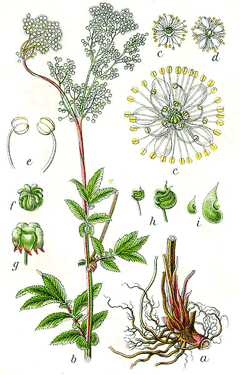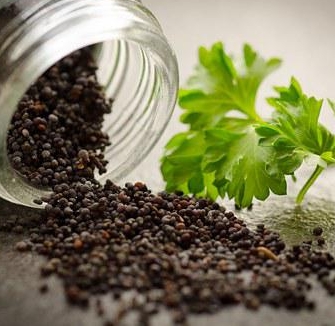So Sweet Is Meadowsweet
In Herbal, John Gerard wrote: “The smell [of meadowsweet] thereof makes the heart merry and joyful and delighteth the senses.” That delightful aroma is just the prelude to the real power of this queenly herb.
Once revered by Druids among their three sacred plants (along with mint and vervain), meadowsweet has carried a legacy of healing through the ages. It soothes inflammation, calms irritation, helps tissue heal, and eases pain. In fact, meadowsweet was a direct predecessor to aspirin—its former genus name, Spiraea, inspired the name “aspirin” after salicylic acid was first isolated from it in the 1830s [2].
Unlike synthetic medications, meadowsweet offers gentle relief with its natural buffering compounds, making it kinder on the stomach. No wonder herbalists call her “The Queen of the Meadow.”
MATERIA MEDICA
Latin Name: Filipendula ulmaria
Family: Rosaceae (formerly Asteraceae as per your post, but authoritative sources place it in Rosaceae)
Parts Used: Aboveground plant (flowers, foliage)
Energetics: Bitter, sweet, cool, dry
Actions: Analgesic, anodyne, antacid, antibacterial, antiemetic, anti-inflammatory, antispasmodic, aromatic, astringent, diaphoretic, diuretic, sedative, stomachic, urinary antiseptic
Uses:
- Arteriosclerosis
- Arthritis & rheumatism
- Cellulitis
- Diarrhea (especially in children)
- Edema
- Fever, flu, common colds
- Heartburn & gastric upset
- Inflammation, wounds
- Prostate enlargement
- Urinary tract infections
- Vaginitis
Benefits & Applications
The sweetness in meadowsweet is more than fragrance—it’s a story of sophisticated herbal synergy:
- Anti-inflammatory & Pain Relief: Films of tannins, flavonoids, and salicylates provide soothing relief similar to aspirin but without the harsh effects on digestion. Test-tube and animal studies show promising results for reducing inflammation, though human trials remain limited [1,3,5,9].
- Digestive Soothing & Ulcer Protection: Its astringent tannins tone mucous membranes, offering protection and healing for heartburn, gastritis, and stomach ulcers, even countering aspirin-like irritation [3,8,9].
- Mild Diaphoretic & Diuretic Support: Meadowsweet encourages gentle sweating and urination—useful with fevers or fluid congestion [4].
- Antioxidant & Systemic Support: Rich in phenolic compounds (like salicylic acid, quercetin, rutin), meadowsweet offers cellular protection and supports immune balance [9].
- Traditional Applications: Used historically for fever, colds, joint discomfort, bladder or liver issues—its name “Bridewort” speaks to its role in wedding rituals, aroma, and emotional-cultural presence [2,3,12].
Preparation & Dosage
- Tea: 4–5 g (about 1 tsp) of ground herb in boiling water; steep for 10 minutes; drink several times daily [1,2].
- Tincture: 2–4 mL, three times daily [2,14].
- Traditional Dosage Ranges (per EMA monograph):
- Herbal tea: 1.5–6 g per dose, 2–18 g daily.
- Powdered herb: 250–500 mg per dose, up to 1500 mg daily.
- Tincture (1:5): 2–4 mL per dose, 6–12 mL daily [14].
Safety & Contraindications
- Salicylate Sensitivity: Avoid if allergic to aspirin or salicylates; it may also trigger asthma (aspirin triad) [2,14].
- Bleeding Risk: Use caution if taking blood thinners or NSAIDs due to mild anticoagulant potential [2].
- Pregnancy & Childhood Use: Avoid in pregnancy or breastfeeding; not recommended for children under 18 (EMA monograph guidance) [14].
Final Reflection
Meadowsweet is as fragrant as her aroma suggests—gentle yet powerful, aromatic yet grounding. She brings centuries of reverence, soothing touch, and herbal wisdom in a single bloom. Whether sipped as a warm tea or inhaled as a meadow’s memory, she reminds us that some of the gentlest medicines are the most profoundly sweet.
References
- Healthline. (2021). Meadowsweet Herb: Benefits, Uses, Tea, and More. Retrieved from https://www.healthline.com/nutrition/meadowsweet-herb
- Drugs.com. (2025). Meadowsweet – Uses, Benefits & Dosage. Retrieved from https://www.drugs.com/npp/meadowsweet.html
- Learning Herbs. (n.d.). Meadowsweet Uses and Plant Profile. Retrieved from https://www.learningherbs.com/blog/meadowsweet-uses
- Traditional Medicinals. (n.d.). Meadowsweet: Benefits & Herbal Benefits. Retrieved from https://www.traditionalmedicinals.com/blogs/herb-library/meadowsweet
- Research Journal of Pharmacognosy. (2022). Filipendula ulmaria: Traditional Uses, Phytochemistry & Pharmacology. Farzaneh et al.
- PeaceHealth. (n.d.). Meadowsweet – Health Information Library. Retrieved from https://www.peacehealth.org/medical-topics/id/hn-2129002
- Herbal Reality. (n.d.). Meadowsweet – Herb Details. Retrieved from https://www.herbalreality.com/herb/meadowsweet/
- Eatweeds. (2018). Meadowsweet (Filipendula ulmaria). Retrieved from https://www.eatweeds.co.uk/meadowsweet-filipendula-ulmaria
- PMC. (2018). Meadowsweet Teas as New Functional Beverages. Retrieved from https://pmc.ncbi.nlm.nih.gov/articles/PMC6155584/
- Wikipedia. (2025). Filipendula ulmaria. Retrieved from https://en.wikipedia.org/wiki/Filipendula_ulmaria
- Wikipedia. (2025). List of Strewing Herbs. Retrieved from https://en.wikipedia.org/wiki/Strewing_herb
- ResearchGate. (2022). Filipendula ulmaria (Meadowsweet) Review. Retrieved from https://www.researchgate.net/publication/361723340_Filipendula_ulmaria_A_Review_of_Traditional_Uses_Phytochemistry_and_Pharmacology
- Traditional European Pharmacopoeia (EMA). (2011). Community Herbal Monograph: Filipendula ulmaria. Retrieved from https://www.e-lactancia.org/media/papers/Ulmaria-EMA2011.pdf



